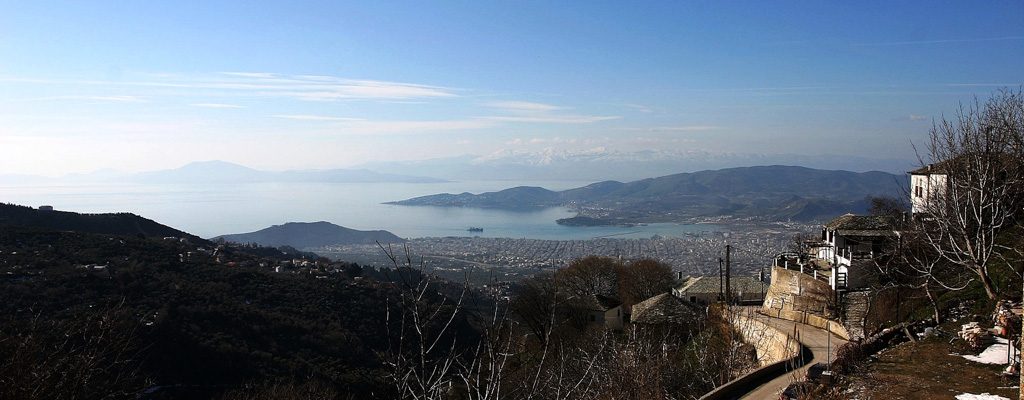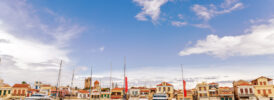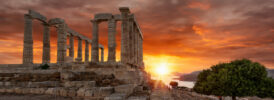Wherever you go in Greece, there will not be just one story, but several. This is such an ancient country, and its history has many layers. The Panigiraki – the feast day of Agios Giorgos- in Arachova, is just such a story.
The Panigiraki of Arachova: Reliving Traditions with Ancient Roots
Village Feast Days
Greece is a country that loves celebration. One of the main types of celebrations in Greece is the village feast day. Every village, no matter how small, has a patron saint. This is the saint who is honored in the main church of the village. There are saints’ days, and therefore individual village feast days, throughout the year.
These celebrations are a time when everyone goes back to his or her ancestral village from the cities. It’s like a family reunion, but much larger. This is a time to keep culture intact, and strengthen the connection to the past through traditions. Folkloric costumes and traditional music and dance are an important part of these festivities.

Some Saints are extremely popular, and the days honoring them give shape to the calendar of Greek life. For instance, Agios Dimitrios day is celebrated on October 26th, and marks the beginning of the winter season. Saint George’s Day, the feast day in Arachova, marks winter’s end.
Saint George, Saint of the Shepherds
Saint George – Agios Georgios – is *usually celebrated on April 23rd. His name day signals the beginning of Spring. This is the time when, traditionally, the fields are planted, and the flocks are taken to graze again on mountain slopes. The Saint is dear to shepherds for this reason.

Some of these celebrations have been going on for centuries. And one of them is particularly famous. The feast day of Agios Giorgos is celebrated in Arachova in a way it is celebrated nowhere else.
Saint George, the Slayer of Dragons
The feast day of Saint George in Arachova is a three day affair. Here, the local legend is that Saint George slayed a dragon. This dragon was blocking the water supply and would only grant the people access when he was given a sacrifice. But this tale is not unique to Arachova. Saint George’s legend always has him slaying a dragon to save a human sacrificial victim, a legend that spread throughout the Byzantine world in the 12th Century. This legend, in turn, had its roots in Ancient Greek Mythology- Perseus saving Andromeda from the dragon-like sea monster, for instance. Celebrations like this touch on Greece’s ancient past.
You’ll nearly always see Saint George depicted slaying a dragon in icons on Greek Orthodox churches.
A Byzantine Celebration- The Panigyraki
Like the legend of the Saint, the celebration held here in Arachova in his honor has roots right back to the Byzantine era. And what a celebration! The first day, there is an evening mass, then a great procession of the icon of St. George throughout the town. Start by climbing the many steps to the Church to light a candle. On the main day of the festival, an enormous grill is set up in the square, and some families grill their lambs communally.

There will be music from drums called ‘daouli’, and from flutes called ‘pipiza’. The men’s costumes feature ‘fustanellas’- full skirts worn like the warriors of the War of Independence (like the ‘Evzoni’ of the Presidential Guard wear in Athens). The women wear long skirts with beautiful embroidered aprons and headscarves. These are examples of fine traditional handiwork. Local embroidery and weaving are very prized here. Feasting and celebration with music and dance continue into the night.
The next day, there are sports competitions. The participants dress in traditional costume, and compete in long jump, high jump, stone lifting, shot put, and a vigorous steep uphill run. What is the prize, you may wonder? A lamb. Not for the grill, but a live one!
The Church of St. George of Arachova
This church is also special for another reason. It was the site of a significant Battle in the War of Independence. The Battle of Arachova was intended to divert attention from the siege of Athens, and it was a success.
Boeotia
The Panigyraki in celebration of Saint George are an excellent occasion to explore the true Greece. Greece is so much more than its extraordinary sea coast, and its season is endless- not just the summer months that draw most of the visitors. It is a rich destination of wonder and culture throughout the year. And here, in the foothills of Mt. Parnassus, you have the opportunity to experience one of the other wonders of the Greek landscape.

Arachova is an ancient place. Boeotia, the region where Arachova sits, has been inhabited continuously since at least the 6th century BC. This is the same province where the most famous of the ancient Oracles – Delphi – is located. A visit to Boeotia gives the visitor the opportunity to share in the richness of the Greek experience, from the most ancient and sacred of sites, to local folkloric customs with Byzantine roots, to extraordinary landscape.

Arachova has plenty of rustic charm, but its nearness to Athens and to the Ski resorts of Mt. Parnassos ensure a level of cosmopolitan sophistication. Elegant accommodations and gourmet food can be enjoyed, and there are delicious local wines. This is the place to have an authentic Greek experience, with a high level of hospitality and service.
Have you ever experienced Greece off-season?
*If the feast day falls before Easter, as sometimes it does and as it does this year, it is moved to the Monday after Easter. Holy week is the most solemn week of the Christian year, and no celebrations can be held until after Easter.





